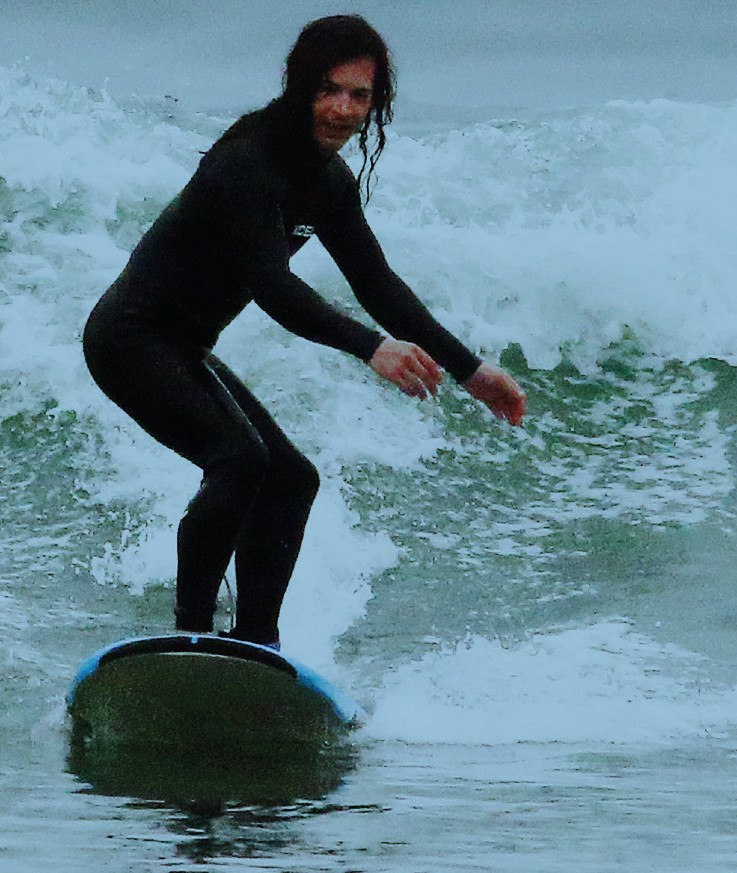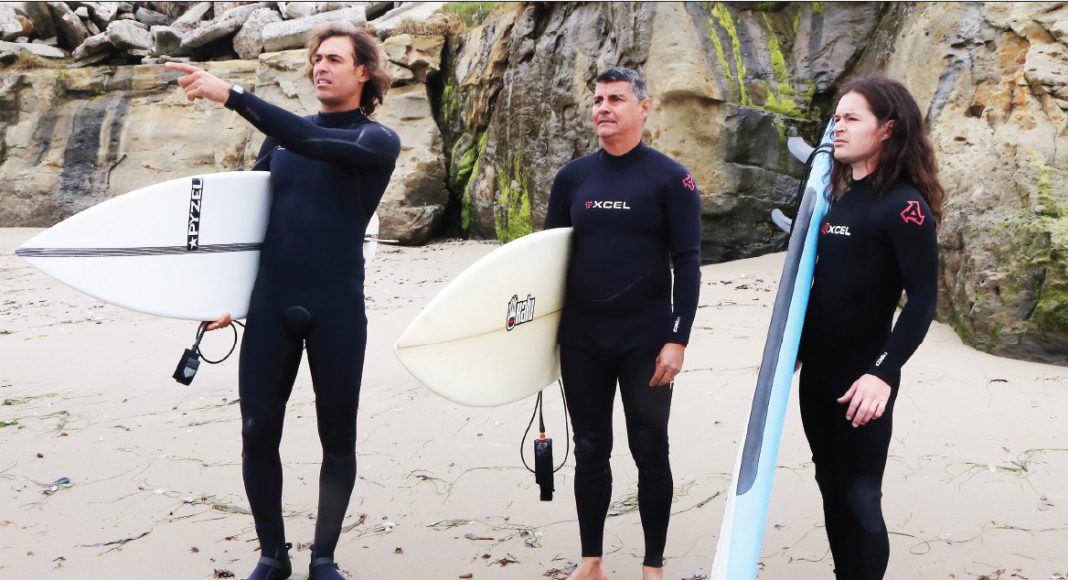Under normal circumstances, if one is invited to go surfing with a clown from over the hill, the answer is no.
But this particular invitation wasn’t coming from just any clown. It was issued by Clement Malin, a French circus artist who currently stars in Cirque du Soleil’s Echo, performing under the big top at the Santa Clara County Fairgrounds through May 11.
I recently saw Echo and had the distinct privilege of watching Malin and fellow clown Thomas Gaskin perform their awe-inspiring “Double Trouble” act, which involves a humorous and precarious attempt to stack an ever-growing, towering pile of cardboard boxes, captivating audiences with its blend of slapstick and skillful coordination.
I will admit to not having a deep love of clowns in general, but this performance, which is woven throughout the entire Echo show—keeping the audience engaged and entertained as costumes are changed, rigging is adjusted and sets are reconfigured—is among the most charming and delightful I’ve ever seen. It’s also mind-blowing in its own way once they stack 24 boxes, which each weigh about 2 pounds (53 pounds total), to a height of 32 feet, toying with the audience, pretending it will fall, heightening the tension and bringing everyone to the edge of their seats. I won’t spoil the ending, but let’s just say it all results in peals of unbridled laughter.
Originally trained as an acrobat, Malin incorporates a mind-boggling ladder trick into the Double Trouble act and this is when his skill as a comedic, acrobatic performer becomes profound. This isn’t your basic tripod ladder for household chores. This is a balance ladder (also called a free-standing ladder) with two legs—basically stilts—that must be precisely balanced to stay upright, all while Malin climbs atop it.
When Malin climbs to the very top and by some miracle stays perched there, still delivering his clown shtick as if he’s on solid ground, the crowd gives a collective, amazed “Whoa!” Like in most Cirque du Soleil performances, we’re all thinking, “how the @#$%^ do they do THAT?!” The insane things these performers make look simple, easy and everyday would be utterly impossible for the rest of us and it is that recognition that gets the crowd up and onto its feet in rousing applause.
In each city that the Cirque du Soleil performers visit, they find ways to take a break on their off days to rest, rejuvenate and check out the local culture. The legendary Santa Cruz surf scene appealed to Malin, who is relatively new to the sport, so he, his wife and their 1-year-old daughter, who all travel together during the show’s tour, came over to Pleasure Point for the day.
In addition to getting some fresh air, enjoying the ocean and experiencing our marine life, Malin was interested in exploring the parallels between surfing and the work he does as a clown. Both look deceptively easy to the untrained eye, but require skill, intuition, balance, strength, impeccable timing, flexibility and taking calculated risks. You also can’t take yourself too seriously because Mother Nature will show you a thing or two!

Upon first meeting Malin, his demeanor surprises me. Naturally I wasn’t expecting him to have fuzzy hair, big shoes and a red nose. But I also didn’t imagine he’d be so pensive. As we engage in conversation, he listens intently and responds with deeply philosophical, sometimes poetic phrases. He strikes me as a Serious Person.
Since this is just my first impression, and he’s the only clown I’ve ever met, I ask him about it—I’m curious to know if he thinks of himself as funny. He ponders this, makes a shy face, looks down at his feet and says “I can be funny…” His voice trails off. It’s clear that there are a lot of layers to this individual. He performs as a clown, but that is not his sole persona. While I ponder the fine line between comedy and tragedy, our conversation moves on.
Asked about what it takes to be successful as a clown, he offers another unexpected response. “You have to become as empty as possible so you can receive,” he says. “To make the moment possible.”
To what “moment” is he referring, I ask. “There is love as a single thing. Then there is this greater collective love when the audience gathers together. Almost like communion. It’s a beautiful feeling.” And then his inner jester comes out: “This is why I do not need therapy,” he smiles broadly and his eyes light up.
For someone who teeters atop a stilt-ladder for a living, it’s not surprising that Malin makes repeated references to striking the right balance. “You first have to fully master what you are doing, then decide to make it look easy or make it look hard. To play with the audience. The path in between is where you find the freedom to act.”
From yoga to surfing to other forms of wellness and stress reduction, we often hear how important it is to “be in the now” or “stay in the present moment.” For Malin, these things are not optional. “It’s a mental game,” he says. “There is inherent, intense risk. And there is mental presence. You have to be 100% there and present. In my world, the answer to non-presence is falling. You cannot fake it.”
For Malin, who greatly enjoys improvisation, the most challenging part of his work is the repetition. Cirque du Soleil strives to create the exact same show, the same experience, over and over for each and every performance. He applies his mental presence to this challenge as well. “When I step onto the stage, I switch on. When I leave the stage, I switch off.” To keep things fresh, he says, “I try to find a new challenge every day. I find some new thing to focus on.”
Paradoxically perhaps, the way Malin learned and ultimately mastered his ladder act is by training to fall. He started on a much shorter version of the ladder used in the Cirque du Soleil performances, steadily increased the height and learned exactly how to fall. Then he focused on not falling.
“It was early on in my career when I saw another performer using the ladder,” Malin recalls. “I was performing and building my own act, but I did not have a specialty yet. When I saw this other guy using the ladder, I didn’t believe it was possible. But he showed me. I saw that it was possible. I went out and bought my own ladder the very next day.”
Eager to get a taste of the waves, Malin zips up his wetsuit, attaches his leash and plunges eagerly through the small waves at Jack’s and paddles out to the line-up. (He was very impressed to be surfing in front of the legendary Jack O’Neill’s former home.)
Not his first time on a board, he catches a number of waves fairly quickly, displaying a level of form, ease and grace that’s fitting for someone so, well, fit. He is diminutive in height, but muscular and strong. No pudgy clown here. More like zero percent body fat. He is a natural at surfing.
He paddles back in and when I ask how it was, his first response is “cold!” but it’s said with a hearty laugh and oodles of French gusto. He glances up to smile at his wife and their daughter, who is playing eagerly in the sand and sporting the cutest little sunglasses.
“I don’t know enough about surfing yet to tell you the parallels with being a clown or an acrobat,” he admits. But we discuss it further and ultimately agree that great timing, starting small, staying present, not being too strict, adapting, learning how to fall and knowing when to improvise are all things that surfing and clowning have in common.
How does Malin measure his success as a clown? By the laughs, perhaps? Nope. Now that I’ve gotten to know him a bit I’m not surprised to hear from Malin another contemplative, deep response. “If I can get the audience to trust me, then they will trust each other. If those things happen, then I’ve achieved my goal.”
Editor’s note: On April 30, name spellings in first photo and the name of Clement Malin’s partner in Double Trouble were corrected.














what’s with the obnoxious pop up ‘donate’ balloon on this website ??
Me and some buddies met performers from Cavalia years back. (the horse version of CDC) Pierre Luc is the only person I’ve ever taken out who learned to surf in one session. Jumping from horseback to horseback transfers to riding the wild surf 4 sure.